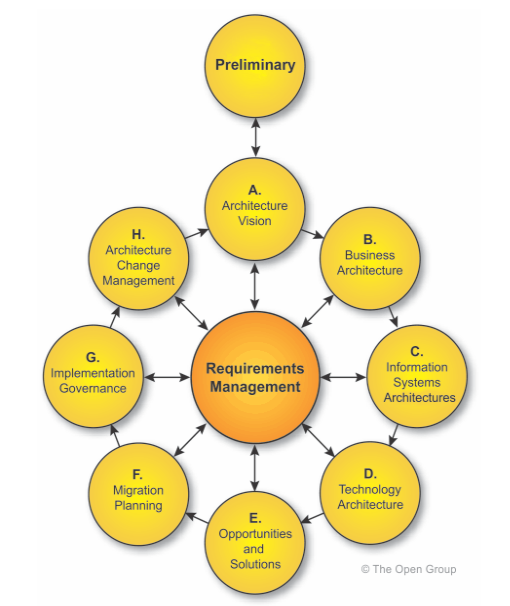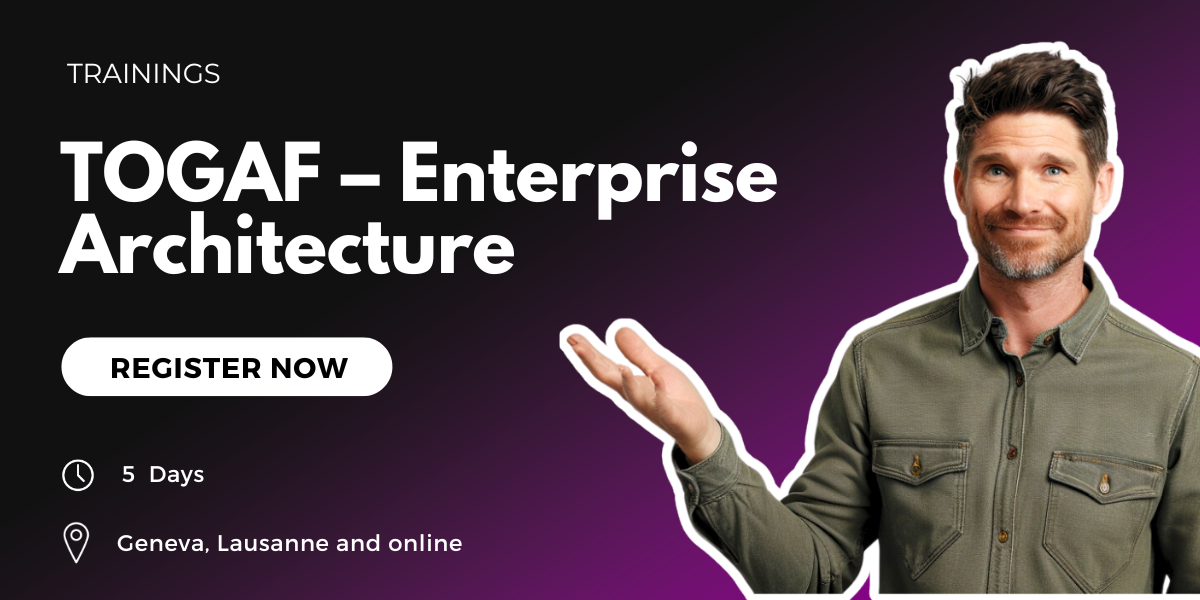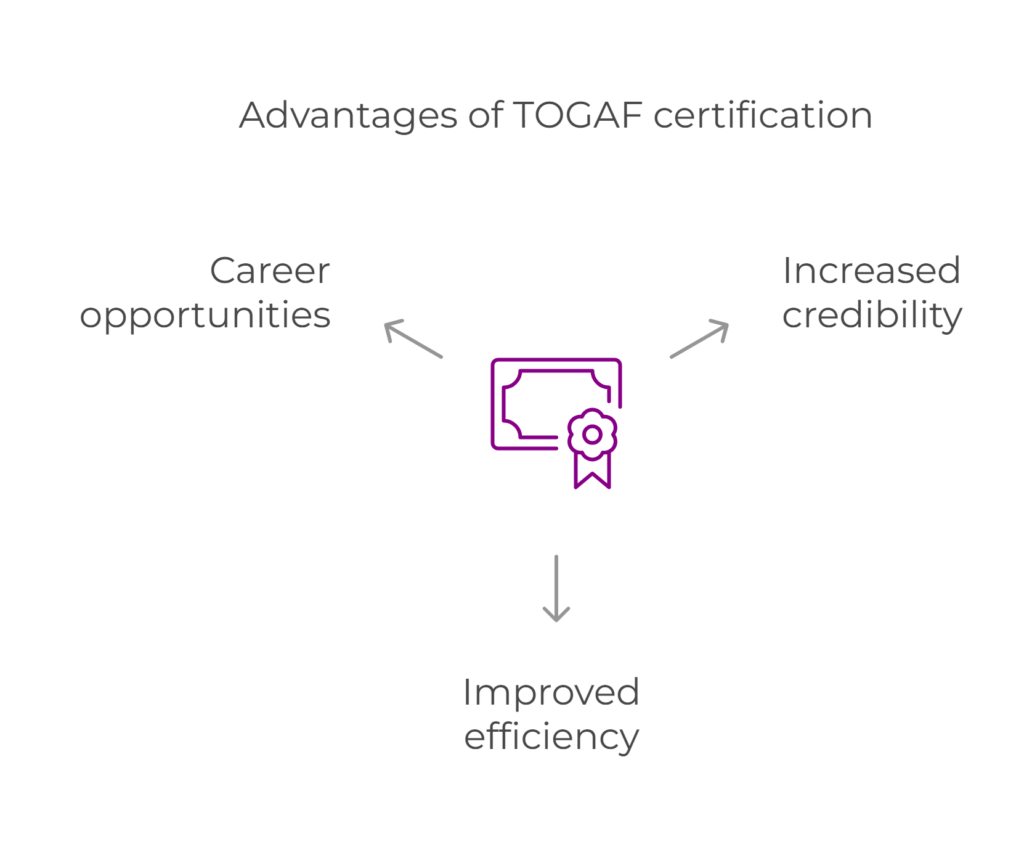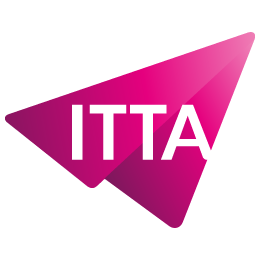Home > TOGAF Certification: An Asset for Success in Enterprise Architecture
Do you want to stand out in the field of enterprise architecture? What if the TOGAF certification became your best asset? Recognized worldwide, this methodology aligns IT strategies with business objectives, ensuring tangible results. According to a study by The Open Group, more than 80% of companies using TOGAF report improved operational efficiency. But why is TOGAF so popular with professionals and companies? What benefits does it offer to those who master it? Discover everything you need to know about TOGAF and how our training can help you obtain this certification in this article.

TOGAF is recognized as a valuable framework for structuring enterprise architecture approaches, enabling organizations to navigate their digital transformation. By aligning enterprise architecture with strategic objectives, TOGAF optimizes companies’ operational efficiency.
But to truly appreciate the impact of TOGAF, it is essential to understand in depth what it represents and its objectives.
TOGAF, or The Open Group Architecture Framework, is a methodology and enterprise architecture framework developed by The Open Group. Created in 1995 from the TAFIM framework by the United States Department of Defense, TOGAF was designed to align IT strategies with business objectives. Used by companies, government agencies, and non-governmental organizations, TOGAF offers a structured approach to designing, planning, implementing, and governing IT architecture. Mastering TOGAF not only enhances a professional’s credibility but also provides an adaptable methodology for managing complex architectures.
The TOGAF standard enables companies to adopt a comprehensive approach to enterprise architecture, facilitating effective management of digital transformations. It promotes the design of robust and well-governed solutions. This combination of structure and flexibility has made TOGAF an invaluable tool for many organizations worldwide.
The primary objective of TOGAF is to provide a standardized approach to reduce costs associated with architecture projects. By aligning processes and technologies with strategic goals, it helps organizations achieve greater operational efficiency.
This standardization not only reduces unnecessary expenses but also creates more agile systems that respond quickly to market changes.
The structure of TOGAF is based on the Architecture Development Method (ADM), a phased approach to managing the lifecycle of an architecture. The ADM consists of nine phases that guide the development, governance, and maintenance of enterprise architecture, ensuring consistency throughout the process. This iterative, phase-based methodology enables adaptability during the development of enterprise architecture, fostering collaboration among various stakeholders.
In addition to the ADM, TOGAF provides a comprehensive toolkit that includes techniques and recommendations to help architects implement enterprise architecture effectively. Various tools and online resources, such as templates, guides, and training programs, are available to facilitate the implementation of TOGAF.
The practices and guidelines provided by the TOGAF standard offer established concepts and best practices for enterprise architecture, allowing organizations to tailor their architectural approach to their specific needs.

Obtaining the TOGAF certification is a well-structured process that requires proper preparation and a thorough understanding of enterprise architecture concepts. This process is divided into multiple levels and offers different training options to suit the needs of working professionals.
The TOGAF certification is available at multiple levels, including TOGAF Foundation and TOGAF Certified. These certifications, based on the TOGAF Standard, Version 9.2, and the 10th edition, cover various areas of specialization such as enterprise architecture, data architecture, application architecture, and technical architecture.
To obtain the TOGAF Certified certification, candidates must demonstrate a deep understanding of advanced enterprise architecture concepts.
To prepare for the TOGAF certification, several training options are available. Online courses offer valuable learning flexibility for working professionals, while classroom training provides a more immersive experience.
These training options are designed to provide the knowledge needed to pass the TOGAF exams successfully.

Taking the TOGAF exam is a crucial step in obtaining the TOGAF certification.
Success in the TOGAF exam not only demonstrates an understanding of the fundamental concepts of enterprise architecture but also the ability to apply these concepts in real-world situations. It is a decisive step toward gaining professional recognition and accessing leadership roles in the field of enterprise architecture.
| Exam Name | Body of Knowledge | Exam Reference | Number of Questions | Time Limit |
|---|---|---|---|---|
| TOGAF® 9 Part 1 | TOGAF Standard, Version 9.2 | OG0-091 (English), OG0-094 (Brazilian Portuguese), OG0-096 (Simplified Chinese), OG0-F91 (French), OG0-S91 (Latin American Spanish) | 40 | 1 hour |
| TOGAF® 9 Part 2 | TOGAF Standard, Version 9.2 | OG0-092 (English), OG0-095 (Brazilian Portuguese), OG0-097 (Simplified Chinese), OG0-F92 (French), OG0-S92 (Latin American Spanish) | 8 | 1 hour 30 minutes |
| TOGAF® 9 Combined Part 1 and Part 2 | TOGAF Standard, Version 9.2 | OG0-093 (English), OG0-098 (Simplified Chinese) | 48 | 2 hours 30 minutes |
| TOGAF® Business Architecture Part 1 | TOGAF Standard, Version 9.2 | OGB-001 (English) | 30 | 45 minutes |
| TOGAF® Enterprise Architecture Part 1 | TOGAF Standard, 10th Edition | OGEA-101 (English), OGEA-F101 (French), OGEA-C101 (Simplified Chinese) | 40 | 60 minutes |
| TOGAF® Enterprise Architecture Part 2 | TOGAF Standard, 10th Edition | OGEA-102 (English), OGEA-F102 (French), OGEA-C102 (Simplified Chinese) | 8 | 90 minutes |
| TOGAF® Enterprise Architecture Combined Part 1 and Part 2 | TOGAF Standard, 10th Edition | OGEA-103 (English), OGEA-C103 (Simplified Chinese) | 48 | 2 hours 30 minutes |
| TOGAF® Business Architecture Foundation | TOGAF Standard, 10th Edition | OGBA-101 (English), OGBA-C101 (Simplified Chinese) | 40 | 60 minutes |
| TOGAF® Enterprise Architecture Bridge | TOGAF Standard, 10th Edition | OGEA-10B (English), OGEA-F10B (French), OGEA-C10B (Simplified Chinese) | 14 | 60 minutes |
The benefits of TOGAF certification are numerous and varied, ranging from increased professional credibility to improved operational efficiency, as well as enhanced career opportunities.
TOGAF-certified professionals enjoy enhanced recognition from their peers and employers, strengthening their credibility. This certification is seen as a mark of competence and reliability, which facilitates acceptance into leadership roles within organizations.
Thanks to this recognition, TOGAF experts can play a strategic role in their company’s digital transformation.
The application of TOGAF significantly improves the efficiency of enterprise architecture processes. Companies that have adopted TOGAF report notable improvements in resource management and cost reduction, particularly through better process alignment. The TOGAF methodology also facilitates adaptability to market changes, optimizing internal processes.
In short, TOGAF certification plays a key role in creating effective enterprise architectures that are responsive to market demands. This results in better-structured systems capable of quickly adapting to technological advancements and customer needs.
Holding a TOGAF certification can significantly improve the job prospects of professionals in the field of enterprise architecture. Certified individuals frequently access leadership or IT strategy roles, as well as specialized positions within organizations.
The TOGAF certification opens up numerous career opportunities. Certified professionals can pursue roles such as enterprise architect, digital transformation consultant, or chief information officer (CIO). According to a Glassdoor study, the average salary of a TOGAF architect exceeds €80,000 per year in Europe.

Applying TOGAF within a company requires a thorough understanding of the framework’s principles to ensure effective integration into existing operations. This framework offers a methodology and proven practices to guide architecture projects.
The TOGAF Architecture Development Method (ADM) is essential for guiding architecture projects by providing a systematic and adaptable approach. The ADM cycle, structured into iterative phases, allows for adaptability during the development of enterprise architecture, promoting collaboration among various stakeholders. This method also helps structure projects, leading to smoother and more efficient execution.
TOGAF-certified professionals can apply standardized methodologies, resulting in more efficient architecture processes and better alignment of enterprise architectures with the organization’s strategic objectives.
The TOGAF certification offers numerous benefits for enterprise architecture professionals, including increased credibility, improved efficiency, and enriching career opportunities. By understanding TOGAF’s objectives and structure, going through the certification process, and applying its methodologies and practices within organizations, you can transform your career and play a key role in your organization’s digital transformation. Don’t wait any longer to embark on this journey and become an essential player in enterprise architecture.
What is TOGAF?
The Open Group developed TOGAF, an enterprise architecture framework that aligns IT strategies with business objectives, facilitating the design and governance of IT architecture. This framework is essential for effectively integrating IT and business processes.
What are the levels of TOGAF certification?
The TOGAF certification levels are TOGAF 9 Foundation and TOGAF 9 Certified. Each level covers specialized areas such as enterprise architecture and data architecture. These certifications validate architecture skills within organizations.
How to prepare for the TOGAF certification?
To prepare for the TOGAF certification, it is essential to take accredited courses online or in a classroom setting. It is also highly recommended to use appropriate resources and purchase exam vouchers.
What are the benefits of TOGAF certification?
TOGAF certification provides significant credibility and opens up enriching career opportunities while improving the efficiency of enterprise architecture professionals. Its international recognition allows certified individuals to stand out in the job market.
How is TOGAF implemented in organizations?
Organizations implement TOGAF through a deep understanding of its principles and the use of the Architecture Development Method (ADM), which systematically guides architecture projects. This method, combined with online tools and resources, enables effective adaptation to the specific needs of each company.

ITTA is the leader in IT training and project management solutions and services in French-speaking Switzerland.
Our latest posts
Subscribe to the newsletter
Consult our confirmed trainings and sessions

Nous utilisons des cookies afin de vous garantir une expérience de navigation fluide, agréable et entièrement sécurisée sur notre site. Ces cookies nous permettent d’analyser et d’améliorer nos services en continu, afin de mieux répondre à vos attentes.
Monday to Friday
8:30 AM to 6:00 PM
Tel. 058 307 73 00
ITTA
Route des jeunes 35
1227 Carouge, Suisse
Monday to Friday, from 8:30 am to 06:00 pm.